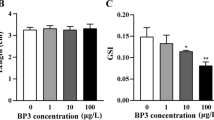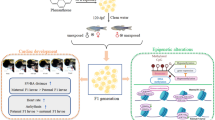Abstract
Polybrominated diphenyl ethers (PBDEs) are widely used as flame retardants around the world. Because of large production volumes, widespread usage and persistence, PBDEs are now ubiquitous environmental pollutants detected in a wide variety of environment media and human samples and therefore pose a significant public health concern. Deca-PBDE (BDE-209) is the only commercial PBDE mixture still allowed for use at present, and has been recently detected at high levels in human samples. However, few studies explore its effect on development, reproduction or neurobehavior with animal models. In particular, studies with long-term chronic exposure at relatively low doses are lacking. In this study, we utilize the zebrafish model to explore the developmental, reproductive, and behavioral toxicities associated with long-term chronic exposure to deca-PBDE (BDE-209). Our findings revealed that long-term chronic exposure to low dose of deca-BDE (ranging from 0.001 to 1 μM) affected overall fitness (measured by condition factor), gonad development, male gamete quantity and quality in F0 parental fish. For F1 offspring without continuous exposure to BDE-209, parental BDE treatment led to delayed hatch and motor neuron development, loose muscle fiber, slow locomotion behavior in normal conditions, and hyperactivity when subjected to light–dark photoperiod stimulation. In conclusion, parental chronic low dose BDE-209 exposure not only affects F0 growth and reproduction, but also elicits neurobehavior alternations in F1 offspring.





Similar content being viewed by others
References
Bayen S, Lee HK, Obbard JP (2004) Determination of polybrominated diphenyl ethers in marine biological tissues using microwave-assisted extraction. J Chromatogr A 1035:291–294
Bervoets L, Blust R (2003) Metal concentrations in water, sediment and gudgeon (Gobio gobio) from a pollution gradient: relationship with fish condition factor. Environ Pollut 126:9–19
Bi X, Thomas GO, Jones KC, Qu W, Sheng G, Martin FL, Fu J (2007) Exposure of electronics dismantling workers to polybrominated diphenyl ethers, polychlorinated biphenyls, and organochlorine pesticides in South China. Environ Sci Technol 41:5647–5653
BSEF (2003) Bromine Science and Environmental Forum (BSEF), 2001. http://www.bsef.com
Buckingham SD, Ali DW (2004) Sodium and potassium currents of larval zebrafish muscle fibers. J Exp Biol 207:841–852
Buss RR, Drapeau P (2002) Activation of embryonic red and white muscle fibers during fictive swimming in the developing zebrafish. J Neurophysiol 87:1244–1251
Chou CT, Hsiao YC, Ko FC, Cheng JO, Cheng YM, Chen TH (2010) Chronic exposure of 2,2′,4,4′-tetrabromodiphenyl ether (PBDE-47) alters locomotion behavior in juvenile zebrafish (Danio rerio). Aquat Toxicol 98:388–395
Costa LG, Giordano G (2007) Developmental neurotoxicity of polybrominated diphenyl ether (PBDE) flame retardants. Neurotoxicology 28:1047–1067
de Graaf F, van Raamsdonk W, van Asselt E, Diegenbach PC (1990) Identification of motor neurons in the spinal cord of the zebrafish (Brachydanio rerio), with special reference to motor neurons that innervate intermediate muscle fibers. Anat Embryol 182:93–102
de Wit CA (2002) An overview of brominated flame retardants in the environment. Chemosphere 46:583–624
Drapeau P, Ali DW, Buss RR, Saint-Amant L (1999) In vivo recording from identifiable neurons of the locomotor network in the developing zebrafish. J Neurosci Methods 88:1–13
Flanagan-Steet H, Fox MA, Meyer D, Sanes JR (2005) Neuromuscular synapses can form in vivo by incorporation of initially aneural postsynaptic specializations. Development 132:4471–4481
Gee JR, Moser VC (2008) Acute postnatal exposure to brominated diphenylether 47 delays neuromotor ontogeny and alters motor activity in mice. Neurotoxicol Teratol 30:79–87
Greek-Walker M, Pull GA (1975) A survey of red and white muscle in marine fish. J Fish Physiol 7:295–300
Hallgren S, Sinjari T, Håkansson H, Darnerud PO (2001) Effects of polybrominated diphenyl ethers (PBDEs) and polychlorinated biphenyls (PCBs) on thyroid hormone and vitamin A levels in rats and mice. Arch Toxicol 75:200–208
Hoppe A, Carey G (2007) Polybrominated diphenyl ethers as endocrine disruptors of adipocyte metabolism. Obesity (Silver Spring) 15:2942–2950
Huang H, Huang C, Wang L, Ye X, Bai C, Simonich MT, Tanguay RL, Dong Q (2010) Toxicity, uptake kinetics and behavior assessment in zebrafish embryos following exposure to perfluorooctanesulphonicacid (PFOS). Aquat Toxicol 98:139–147
Jin J, Wang Y, Yang C, Hu J, Liu W, Cui J, Tang X (2009) Polybrominated diphenyl ethers in the serum and breast milk of the resident population from production area, China. Environ Int 35:1048–1052
Jing R, Huang C, Bai C, Tanguay RL, Dong Q (2009) Optimization of activation, collection, dilution, and storage methods for zebrafish sperm. Aquaculture 290:165–171
Kimmel CB, Ballard WW, Kimmel SR, Ullmann B, Schilling TF (1995) Stages of embryonic development of the zebrafish. Dev Dyn 203:253–310
Kuriyama S, Talsness C, Grote K, Chahoud I (2005) Developmental exposure to low dose PBDE 99: effects on male fertility and neurobehavior in rat offspring. Environ Health Perspect Environ Health Perspect 113:149–154
La Guardia MJ, Hale RC, Harvey E (2007) Evidence of debromination of decabromodiphenyl ether (BDE-209) in biota from a wastewater receiving stream. Environ Sci Technol 41:6663–6670
Lawrence C, Ebersole J, Kesseli R (2007) Rapid growth and out-crossing promote female development in zebrafish (Danio rerio). Environ Biol Fish 81:239–246
Levin E, Aschner M, Heberlein U, Ruden D, Welsh-Bohmer K, Bartlett S, Berger K, Chen L, Corl A, Eddins D, French R, Hayden K, Helmcke K, Hirsch H, Linney E, Lnenicka G, Page G, Possidente D, Possidente B, Kirshner A (2009) Genetic aspects of behavioral neurotoxicology. NeuroToxicology 30:741–753
Liu D, Westerfield M (1988) Function of identified motoneurones and co-ordination of primary and secondary motor systems during zebra fish swimming. J Physiol 403:73–89
Llansola M, Erceg S, Monfort P, Montoliu C, Felipo V (2007) Prenatal exposure to polybrominated diphenylether 99 enhances the function of the glutamatenitric oxide-cGMP pathway in brain in vivo and in cultured neurons. Eur J Neurosci 25:373–379
Lyche JL, Nourizadeh-Lillabadi R, Almaas C, Stavik B, Berg V, Skåre JU, Alestrøm P, Ropstad E (2010) Natural mixtures of persistent organic pollutants (POP) increase weight gain, advance puberty, and induce changes in gene expression associated with steroid hormones and obesity in female zebrafish. J Toxicol Environ Health A 73:1032–1057
Mai B, Chen S, Luo X, Chen L, Yang Q, Sheng G, Peng P, Fu J, Zeng EY (2005) Distribution of polybrominated diphenyl ethers in sediments of the Pearl River Delta and adjacent South China Sea. Environ Sci Technol 39:3521–3527
Meerts IA, Letcher RJ, Hoving S, Marsh G, Bergman A, Lemmen JG, van der Burg B, Brouwer A (2001) In vitro estrogenicity of polybrominated diphenyl ethers, hydroxylated PDBEs, and polybrominated bisphenol A compounds. Environ Health Perspect 109:399–407
Meironyté D, Norén K, Bergman A (1999) Analysis of polybrominated diphenyl ethers in Swedish human milk, a time dependent trend study, 1972–1997. J Toxicol Environ Health A 58:329–341
Muirhead EK, Skillman AD, Hook SE, Schultz IR (2006) Oral exposure of PBDE-47 in fish: toxicokinetics and reproductive effects in Japanese Medaka (Oryzias latipes) and fathead minnows (Pimephales promelas). Environ Sci Technol 40:523–528
Stoker TE, Cooper RL, Lambright CS, Wilson VS, Furr J, Gray LE (2005) In vivo and in vitro anti-androgenic effects of DE-71, a commercial polybrominated diphenyl ether (PBDE) mixture. Toxicol Appl Pharm 207:78–88
Sylvain N, Brewster D, Ali D (2010) Zebrafish embryos exposed to alcohol undergo abnormal development of motor neurons and muscle fibers. Neurotoxicol Teratol 32:472–480
Talsness CE (2008) Overview of toxicological aspects of polybrominated diphenyl ethers: a flame-retardant additive in several consumer products. Environ Res 108:158–167
Tseng LH, Lee CW, Pan MH, Tsai SS, Li MH, Chen JR, Lay JJ, Hsu PC (2006) Postnatal exposure of the male mouse to 2,2′,3,3′,4,4′,5,5′,6,6′-decabrominated diphenyl ether: decreased epididymal sperm functions without alterations in DNA content and histology in testis. Toxicology 224:33–43
Van den Steen E, Covaci A, Jaspers VL, Dauwe T, Voorspoels S, Eens M, Pinxten R (2007) Accumulation, tissue-specific distribution and debromination of decabromodiphenyl ether (BDE 209) in European starlings (Sturnus vulgaris). Environ Pollut 148:648–653
Viberg H, Mundy W, Eriksson P (2008) Neonatal exposure to decabrominated diphenyl ether (PBDE 209) results in changes in BDNF, CaMKII and GAP-43, biochemical substrates of neuronal survival, growth, and synaptogenesis. NeuroToxicology 29:152–159
Wahl M, Lahni B, Guenther R, Kuch B, Yang L, Straehle U, Strack S, Weiss C (2008) A technical mixture of 2,2′,4,4′-tetrabromo diphenyl ether (BDE47) and brominated furans triggers aryl hydrocarbon receptor (AhR) mediated gene expression and toxicity. Chemosphere 73:209–215
Wahl M, Guenther R, Yang L, Bergman A, Straehle U, Strack S, Weiss C (2010) Polybrominated diphenyl ethers and arylhydrocarbon receptor agonists: different toxicity and target gene expression. Toxicol Lett 198:119–126
Wang Y, Jiang G, Lam PK, Li A (2007) Polybrominated diphenyl ether in the East Asian environment: a critical review. Environ Int 33:963–973
Wang X, Wang F, Wu X, Zhao Z, Liu J, Huang C, Dong Q (2010) The use of cryomicroscopy in guppy sperm freezing. Cryobiology 61:182–188
Westerfield M (1995) The zebrafish book: a guide for the laboratory use of zebrafish (Danio rerio), 3rd edn. University of Oregon Press, Eugene, pp 267–272
Yu L, Deng J, Shi X, Liu C, Yu K, Zhou B (2010) Exposure to DE-71 alters thyroid hormone levels and gene transcription in the hypothalamic–pituitary–thyroid axis of zebrafish larvae. Aquat Toxicol 97:226–233
Zhao Y, Qin X, Li Y, Liu P, Tian M, Yan S, Qin Z, Xu X, Yang Y (2009) Diffusion of polybrominated diphenyl ether (PBDE) from an e-waste recycling area to the surrounding regions in Southeast China. Chemosphere 76:1470–1476
Zhu L, Ma B, Hites RA (2009) Brominated flame retardants in serum from the general population in northern China. Environ Sci Technol 43:6963–6968
Acknowledgments
We thank S. Rodenburg for English editing. This work was supported by funding from the major project of Science and Technology Department of Zhejiang Province (2008C03001-2), the Key Project of Natural Science Foundation of Zhejiang Province (Z2080266), and the National Environmental Protection Public Welfare Science and Technology Research Program of China (200909089).
Author information
Authors and Affiliations
Corresponding authors
Rights and permissions
About this article
Cite this article
He, J., Yang, D., Wang, C. et al. Chronic zebrafish low dose decabrominated diphenyl ether (BDE-209) exposure affected parental gonad development and locomotion in F1 offspring. Ecotoxicology 20, 1813–1822 (2011). https://doi.org/10.1007/s10646-011-0720-3
Accepted:
Published:
Issue Date:
DOI: https://doi.org/10.1007/s10646-011-0720-3




